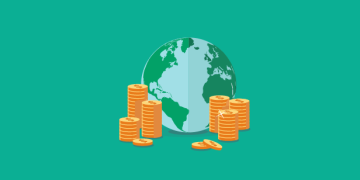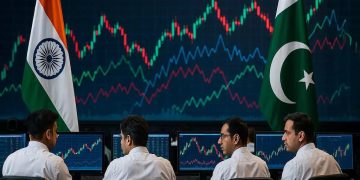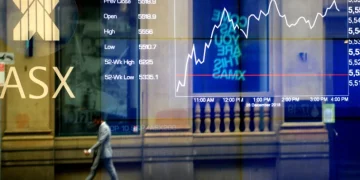A Slower World: The Global Economy Enters a Phase of Soft Deceleration
1. The Calm After the Storm
The global economy, after years of turbulence, seems to be exhaling — not in relief, but in resignation.
The shocks of the early 2020s — pandemic lockdowns, supply chain collapses, inflation spikes, and energy crises — have largely faded. Yet instead of returning to the brisk, synchronized growth of the pre-COVID decade, the world now finds itself in an era of soft deceleration: growth that continues, but at a slower, uneven, and more fragile pace.
According to the International Monetary Fund’s (IMF) latest World Economic Outlook, global GDP growth is projected to ease from 3.3% in 2024 to 3.2% in 2025, and further to around 3.1% in 2026.
The Organisation for Economic Co-operation and Development (OECD) offers an even dimmer forecast, suggesting growth could slide below 3% next year. Both institutions point to similar culprits: weak trade flows, persistent inflation in key economies, and heightened geopolitical uncertainty.
“Momentum is not collapsing,” the IMF’s chief economist Pierre-Olivier Gourinchas noted in July, “but it is certainly thinning.” The world, in short, is still growing — just less confidently, less evenly, and less predictably than before.
2. The Great Divergence Returns
Beneath these aggregate figures lies a story of sharp divergence.
While the early 2020s were marked by synchronized downturns — the pandemic and inflation hit nearly everyone — the mid-2020s are characterized by asynchronous recovery.
- The United States continues to surprise analysts with resilient labor markets and steady consumption. Growth for 2025 is expected at around 2.2%, supported by wage gains and a strong services sector, even as high interest rates bite into investment.
- Europe, by contrast, remains sluggish. The eurozone is forecast to expand barely 1.1%, weighed down by fiscal tightening and weak export demand.
- China, once the engine of global growth, is struggling to sustain momentum as its property crisis drags on and local government debt mounts. Officially, Beijing targets around 4.5–4.8% growth, but analysts suggest the real figure may be lower.
- India stands out as the bright spot, projected to grow 6.5%, continuing its role as the world’s fastest-growing major economy.
This divergence, as economists at McKinsey & Company note, reflects “a multi-speed world” — one where regional strengths and domestic policy decisions matter more than global cycles.
3. The Waning Power of Globalization
The slower rhythm of the world economy is intertwined with a structural transformation in trade.
After decades of globalization that lifted hundreds of millions out of poverty, the 2020s are witnessing a partial retreat — not toward isolation, but toward fragmentation.
The World Trade Organization (WTO) reports that global merchandise trade volume rose about 4.9% in early 2025, a solid rebound from the previous year. Yet the momentum is deceptive. Much of that growth, the WTO cautions, came from front-loaded orders and inventory restocking following 2024’s supply disruptions. The second half of 2025 is likely to see slower expansion, as those temporary boosts fade.
Trade tensions remain an ever-present undercurrent.
In Washington, the re-imposition of tariffs on Chinese goods and new restrictions on critical technology exports have reignited debates about “decoupling.”
In Europe, policymakers are increasingly turning to “de-risking” — diversifying supply chains away from single-country dependencies.
In Asia, regional trade frameworks like RCEP (Regional Comprehensive Economic Partnership) and CPTPP (Comprehensive and Progressive Agreement for Trans-Pacific Partnership) are helping cushion some of the fallout, but the global rules-based system is clearly under strain.
The result is a new form of globalization: regionalized, strategic, and cautious.
Trade still flows, but with higher costs and more conditions attached.
4. Inflation Eases, but Scars Remain
Inflation, the defining story of 2022–2023, has finally begun to retreat.
Global headline inflation averaged 5.8% in 2024 and is expected to fall below 4% by mid-2025, according to the IMF. Commodity prices have stabilized, energy markets are calmer, and supply bottlenecks have largely resolved.
But the scars remain.
Real incomes, eroded by years of price surges, have not fully recovered. Many middle-income households continue to spend cautiously, prioritizing essentials over discretionary goods.
Meanwhile, central banks — particularly the U.S. Federal Reserve and the European Central Bank (ECB) — remain wary of cutting interest rates too quickly, fearing a resurgence of inflation expectations.
The consequence is a policy environment that feels neither tight nor loose — a “neutral zone” that sustains stability but stifles dynamism.
Businesses hesitate to invest amid uncertainty over borrowing costs.
Consumers hesitate to spend amid uncertainty over prices.
Governments hesitate to stimulate amid fears of debt.
The result is what some economists call “structural lethargy” — growth that persists but lacks conviction.

5. Private Consumption: A Fragile Pillar
One of the paradoxes of this slowdown is that global consumption remains remarkably resilient.
Private consumption now accounts for roughly 60% of global GDP, and in countries like the U.S. and India, household spending has kept entire economies afloat.
Even in Europe and Japan, where real wage growth has been modest, pent-up demand for services such as travel, dining, and leisure continues to support output.
Yet cracks are emerging.
In the United States, revolving credit balances have reached record highs.
In Europe, consumer confidence has dipped again, reflecting fears of job insecurity and rising rents.
In China, the household savings rate remains elevated — a sign of caution rather than confidence.
As the OECD notes in its 2025 Economic Outlook, “Consumption can only carry the weight of growth for so long without stronger investment and productivity gains.”
That warning underscores the delicate balance ahead: if consumers pull back, the global slowdown could harden into stagnation.
6. The Debt Overhang
The quiet drag on global growth lies in an unspoken word: debt.
The IMF estimates that global public and private debt reached $315 trillion in 2024 — about 330% of global GDP. The surge, fueled by pandemic relief and subsequent fiscal expansion, has left governments with limited room for maneuver.
As interest rates remain higher for longer, debt-servicing costs are squeezing public finances.
The United States spends more on interest payments than on defense.
Italy and France are approaching unsustainable deficit levels.
Developing economies from Kenya to Pakistan face mounting rollover pressures as dollar financing grows more expensive.
This burden restricts fiscal stimulus, undermines investment, and increases vulnerability to shocks. The debt overhang is not merely an accounting problem — it’s a structural anchor slowing the pace of the global economy.
7. Policy Paralysis in an Age of Uncertainty
Policymakers everywhere face a cruel dilemma.
Loosen too much, and inflation could return.
Tighten too much, and growth could falter.
Act too boldly, and markets could panic.
Do too little, and stagnation sets in.
This paralysis has become a defining feature of 2025.
In Washington, political polarization has reduced fiscal policymaking to short-term bargaining.
In Europe, the re-introduction of fiscal rules limits stimulus options even as economies cool.
In China, authorities face conflicting imperatives — revive growth without reigniting debt bubbles.
The world’s monetary and fiscal systems, once synchronized, now operate at cross-purposes.
As a result, global coordination — the kind seen during the 2008 financial crisis — feels distant and unlikely.
8. Bright Spots Amid the Gloom
Despite the slowdown, not all is bleak.
The services sector remains a robust growth engine, particularly in technology, healthcare, and tourism.
Emerging markets in South and Southeast Asia continue to attract manufacturing investment as firms diversify away from China.
And the green transition, driven by government subsidies and private innovation, is spawning new industries in renewable energy, electric vehicles, and battery storage.
These sectors represent the structural transformation underlying the surface slowdown.
The world may be growing more slowly — but it is also growing differently.
As the IMF puts it, “the composition of growth matters as much as its rate.”
9. The Outlook for the Second Half of 2025
Looking ahead, the global economy’s performance in the latter half of 2025 will hinge on three factors:
1️⃣ Interest rate trajectories — If the Fed and ECB begin cautious rate cuts by late 2025, financial conditions may ease enough to support investment.
2️⃣ Trade stability — The extent to which trade tensions remain contained will determine whether manufacturing can rebound.
3️⃣ Geopolitical risks — Elections, conflicts, and sanctions could yet disrupt fragile supply chains.
Most forecasts converge around a scenario of soft landing — modest growth, cooling inflation, and limited recession risks.
But the margin for error is razor-thin. “We are not out of the woods,” warned OECD Secretary-General Mathias Cormann in September. “We have simply found a slower path through them.”
10. The Age of Moderation
Perhaps the defining feature of the global economy in 2025 is its moderation — of growth, of policy, of ambition.
The post-pandemic boom has faded; the inflation shock has eased. What remains is a quieter, more cautious world economy, driven less by exuberance and more by endurance.
It is tempting to see this as a lull before the next storm. But it may instead mark a new normal — an economy that expands modestly, adjusts frequently, and aspires carefully.
A slower world, yes — but perhaps also a wiser one.
































